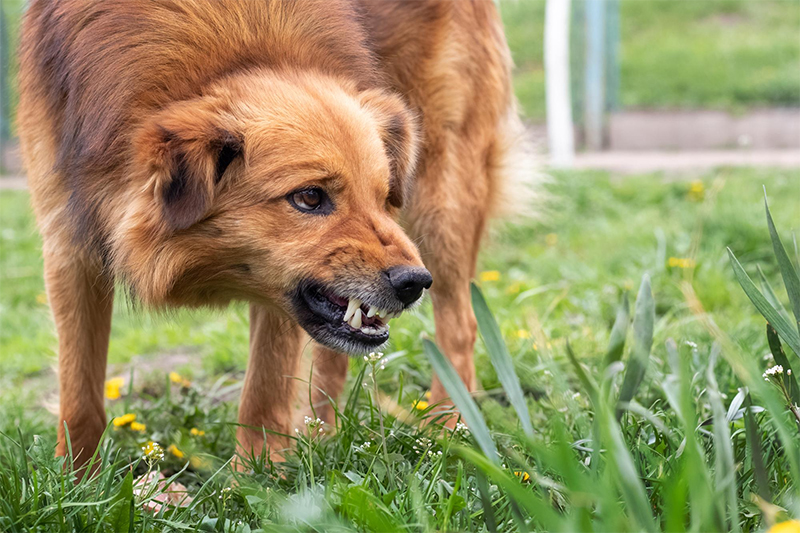Postal workers have long since been harassed by protective dogs. Here are a few tips to stay safe from dog attacks in the course of your mail-delivering duties:
1. Never Startle a Dog
2. Keep Your Eye on Any Dog You Encounter
3. Do Not Assume a Dog Won’t Bite
4. Make Noise or Rattle a Fence to Alert Dog when Entering the Yard
5. Never Attempt to Feed a Dog
6. Use a Dog Repellent
7. Call the Dog’s Name if you Know it and Talk Friendly to the dog

Never Startle a Dog
Dogs can become anxious or fearful when surprised, and this can lead to aggressive behavior and potential bites.
- Approach with caution: When you approach a house with a dog, slow down and approach the property in a non-threatening manner. Give the dog plenty of space and avoid making sudden movements or loud noises.
- Be mindful of your body language: Dogs are very observant and can pick up on your body language. Avoid direct eye contact with the dog, as this can be seen as a challenge. Instead, avert your gaze and keep your body relaxed and calm.
- Stay alert for warning signs: Dogs often give warning signs before they bite. Aggressive dog behavior can include growling, barking, raised fur, or a tense body posture. If you notice any of these signs, back away slowly and give the dog plenty of space.

In the past year, over 5,300 U.S. Postal employees experienced dog attacks while performing their mail delivery duties. [1]
Beware of Any Dog You Cross Paths With – Never Take Your Eyes Off Them!
Dogs are highly perceptive animals. Being aware of their behavior can help you gauge their level of aggression and prevent potential attacks.
- Assessing body language: Dogs communicate through their body language; by watching them closely, you can better understand their intentions. Pay attention to their ears, tail, and posture. A relaxed dog with a loose, wagging tail is usually friendly, while a stiff body, raised hackles, or a low tail can indicate aggression or fear.
- Reacting appropriately: If you encounter a dog displaying aggressive behavior, keeping your eyes on them is essential for understanding their actions and planning your response. Avoid making sudden movements or turning your back on the dog, as this can trigger an attack. Instead, keep your body relaxed, and slowly back away from the dog to give them space.
- Remaining calm: It is important to remain calm, avoid sudden movements, and speak in a soothing tone when dealing with a threatening dog, as they are sensitive to human emotions, and displaying fear or panic can further agitate them.

Do Not Assume a Dog Won’t Bite
Even if a dog seems friendly or has never shown any signs of aggression in the past, remember that dogs are unpredictable creatures. They can react differently in various situations, and you never know what might trigger their aggressive behavior.
One common mistake made by postal workers is assuming that small dogs are harmless and won’t pose a threat. Small dogs may be prone to displaying more aggressive behaviors as they try to assert dominance. So, never let your guard down just because the dog is small or doesn’t seem intimidating.
Postal workers often intrude on a dog’s perceived territory when delivering mail. This intrusion can trigger a protective response from the dog, leading to potential bites. Remember, dogs may see you as an unfamiliar intruder, and their natural instinct may be to defend themselves or their property.
“When our mail carriers are bitten, it is usually a ‘good dog’ that had not previously behaved in a menacing way,” USPS Occupational Safety and Health Senior Director Linda DeCarlo said in a statement. [2]
Make Noise or Rattle a Fence to Alert the Dog when Entering the Yard
By alerting the dog to your presence, you give them the opportunity to be aware of your arrival and reduce the element of surprise.
Dogs rely heavily on their hearing, and by making noise, you can catch their attention and potentially prevent them from feeling startled or threatened. You can achieve this by clapping your hands, knocking on a nearby object, or even using a whistle if you have one readily available.
The key is to make enough noise for the dog to notice your presence and react accordingly.
Rattling a fence can also serve as a warning to the dog. Many dogs are territorial, and when they hear the sound of their fence being disturbed, they may become alert and cautious. This gives them the chance to assess the situation and understand that someone is entering their territory.
By doing so, you allow the dog to prepare itself mentally and potentially reduce the likelihood of them resorting to aggression.

Never Attempt to Feed a Dog
First and foremost, remember that you are a stranger to the dog, and approaching them with food can be seen as an invasion of their personal space. This can lead to an unexpected and potentially dangerous reaction.
Feeding a dog can create a habit that may put future postal workers at risk. Dogs are intelligent creatures, and if they receive food from one postal worker, they may expect it from others as well. We want all postal workers to enjoy a safe mail delivery.
This can lead to a constant demand for food during mail deliveries, increasing the chances of a dog bite incident.
The behavior of dogs can quickly change; even if they have previously been friendly or approached you in a seemingly gentle manner in the past, it is not a guarantee that they will always respond in that way.
Use Dog Repellent
Dog repellent is a spray or device designed to deter dogs from attacking. It assists with attack prevention by emitting a strong odor. It will irritate the dog’s eyes, but leave no lasting harm. In addition to that, it will also turn their fur yellow temporarily, which may help in the identification of a dog if needed.
When encountering an aggressive or threatening dog, it is important to remain calm and avoid sudden movements. Assess the situation and determine if using the dog repellent is necessary.
If the dog displays signs of aggression, such as barking, growling, or lunging, it may be appropriate to use the repellent as a means of self-defense.
To use dog repellent, aim the spray toward the dog’s face or body, following the product’s instructions. Make sure to keep a safe distance to minimize the risk of the dog retaliating. The repellent should create a temporary deterrent, giving you the opportunity to safely retreat from the situation.
Dog repellent is a tool to be used as a last resort when facing an aggressive dog, be careful when using it as it can be irritating to a human’s eyes as well as a dog’s. [3]
Call Dogs by Name (if known) and Talk in a Friendly Manner
When approaching a house with a dog, try to gather information about the dog beforehand. If you know the dog’s name, use it in a calm and friendly tone as you approach. This can help to show the dog that you are not a threat and may even elicit a positive response.
As you call the dog’s name, it is important to speak in a soothing and friendly voice. Avoid using a high-pitched or overly excited tone, as this may agitate the dog further. Instead, use a calm and reassuring tone that conveys that you mean no harm.
Talking to the dog in a friendly manner can also help to establish trust and reduce any feelings of fear or anxiety. While doing so, use open body language. This can signal to the dog that you are not a threat and can help to create a more positive interaction.
The Postal Service also recommends that people not let children take mail directly from a postal worker, since protective pets may think the child is in danger. [2]

It is difficult to stay safe from these protective dogs when in the community, but hopefully, this article has given you some useful tools. If you have been bitten by a dog feel free to reach out to our experienced dog bite lawyers at Goldberg & Loren, find out if you are eligible for compensation.
Sources:
[1] Postal Service releases national dog bite rankings. (2023, June 6). Postal Service Releases National Dog Bite Rankings | Safety+Health. https://www.safetyandhealthmagazine.com/articles/postal-service-releases-national-dog-bite-rankings
[2] Dogs attacked more than 5,300 mail carriers last year, the Postal Service says. (2023, June 4). WSHU. https://www.wshu.org/npr-news/2023-06-04/dogs-attacked-more-than-5-300-mail-carriers-last-year-the-postal-service-says
[3] USPS. (2008, September). How to Avoid Dog Bites; Dogs and Dog Repellent (No. 174). Retrieved August 8, 2023, from https://www.nalc.org/workplace-issues/resources/manuals/other/PUB-174-September-2008-How-to-Avoid-Dog-Bites.pdf

